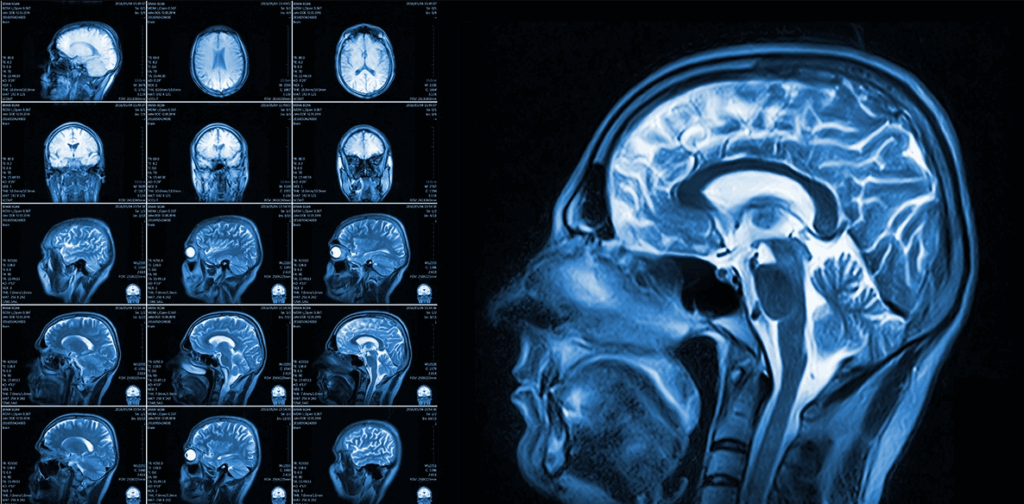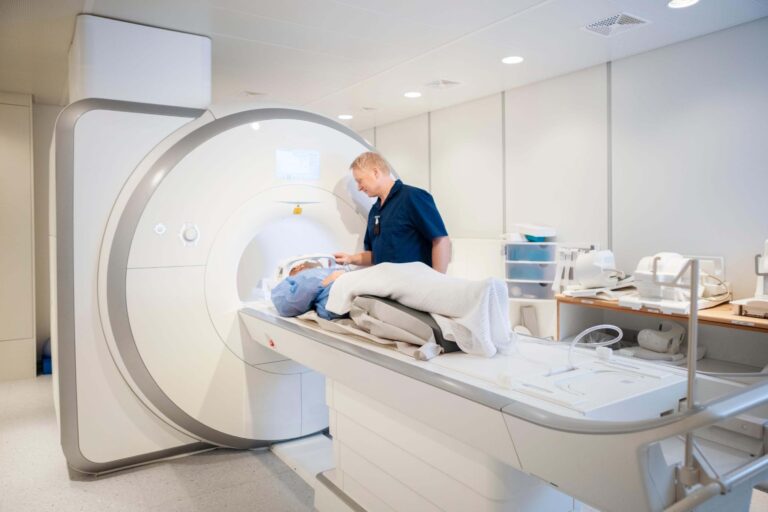Many people feel anxious about their first brain MRI scan, especially when they hear about lying inside a narrow tube. One of the most common questions patients ask is about how much of their body actually goes into the machine during a brain scan.

The good news is that for a standard brain MRI, your entire body does go into the machine, but only your head and neck area need to be positioned precisely inside the strongest part of the magnetic field. Most of your body remains in the wider, more comfortable section of the MRI scanner.
What Actually Happens During a Brain MRI?
Your Position in the Scanner When you lie down on the MRI table, you’ll be positioned so that your head enters the narrow part of the scanner tube. Your shoulders, chest, and the rest of your body remain in the much wider opening at the entrance. Think of it like lying down and sliding your head through a large donut – most of your body stays outside the tight space.
The Scanner Design Modern MRI machines are designed with patient comfort in mind. The opening (called the bore) is typically about 60-70 centimeters wide. While your head needs to be positioned in the center for optimal brain imaging, your body has plenty of room to rest comfortably on the padded table.
Duration and Positioning Most brain MRI scans take between 30-60 minutes to complete. During this time, you’ll need to lie very still on your back. A special coil (which looks like a cage or helmet) will be placed around your head to capture the clearest images possible.
Step-by-Step Process of Your Brain MRI
Before the Scan You’ll change into a hospital gown and remove all metal objects including jewelry, watches, and hearing aids. A technologist will explain the procedure and answer any questions you might have.
Getting Ready You’ll lie down on the padded table, and the technologist will position a head coil around your head. This device doesn’t touch your face but sits close to capture detailed brain images. Foam pads might be placed around your head to help you stay still.
Entering the Scanner The table will slowly slide into the MRI machine. Only your head and upper shoulders enter the narrow part of the scanner. Most of your torso and legs remain in the wider, open area.
During the Scan You’ll hear loud knocking and thumping sounds as the machine takes images. The technologist will give you earplugs or headphones to reduce the noise. Some facilities offer music or allow you to bring your own playlist.

Between Sequences The scan consists of several different sequences, each lasting 3-10 minutes. Between sequences, the noise stops briefly, and you might hear the technologist’s voice through the intercom system.
Completion Once all images are captured, the table slides out of the machine. The entire process typically takes 30-60 minutes, though the actual scanning time is usually shorter.
Precautions and Safety Measures
Metal Screening All metal objects must be removed before entering the MRI room. This includes:
- Jewelry and watches
- Hearing aids and dentures with metal parts
- Clothing with metal zippers or buttons
- Coins and keys
- Credit cards and phones
Medical Implants Inform your doctor about any medical implants such as:
- Pacemakers or defibrillators
- Cochlear implants
- Artificial joints
- Metal plates or screws
- Insulin pumps
Contrast Material Some brain MRIs require contrast dye injected through an IV. This helps highlight certain brain structures and abnormalities. The contrast material used in MRI (gadolinium) is different from CT scan contrast and generally causes fewer allergic reactions.
Claustrophobia Management If you experience claustrophobia, several options can help:
- Anti-anxiety medication before the scan
- Open MRI machines (though image quality may be slightly lower)
- Relaxation techniques and breathing exercises
- Having a family member nearby during the scan
What Makes the Experience More Comfortable
Preparation Tips Arrive early to complete paperwork and ask questions. Wear comfortable clothing without metal components. Bring a list of your medications and medical history.
During the Scan Focus on breathing slowly and steadily. Many patients find it helpful to close their eyes and imagine being somewhere peaceful. The technologist can see and hear you throughout the entire procedure.
Communication You’ll have a squeeze ball or buzzer to alert the technologist if you need assistance. The intercom system allows two-way communication throughout the scan.

Special Considerations for Different Patients
Pregnant Women MRI is generally considered safe during pregnancy, but doctors typically avoid it during the first trimester unless absolutely necessary. No contrast material is used during pregnancy.
Children Pediatric patients might need sedation to remain still during the scan. Child-friendly facilities often have specially decorated scanners and staff trained in working with young patients.
Elderly Patients Extra positioning aids and comfort measures may be provided for elderly patients who have difficulty lying flat or staying still for extended periods.
Patients with Disabilities Special accommodations can be made for patients with mobility issues or other disabilities. Discuss your specific needs with the imaging center when scheduling.
Different Types of Brain MRI Scans
Standard Brain MRI This basic scan provides detailed images of brain structure and can detect tumors, strokes, and other abnormalities.
Functional MRI (fMRI) This specialized scan measures brain activity by detecting changes in blood flow. Patients might be asked to perform simple tasks during the scan.
MRI with Contrast Gadolinium contrast helps highlight blood vessels and certain types of brain lesions. The contrast is injected through an IV during the scan.
MR Angiography (MRA) This technique focuses specifically on blood vessels in the brain and can detect aneurysms, blockages, or other vascular problems.
After Your Brain MRI
Immediate Post-Scan You can resume normal activities immediately after most brain MRI scans. If you received contrast material, you’ll be monitored briefly for any adverse reactions.
Results Timeline A radiologist will analyze your images and send a report to your doctor, usually within 24-48 hours. Your doctor will then discuss the results with you.
Follow-up Scans Some conditions require repeat MRI scans to monitor changes over time. Your doctor will explain if additional imaging is needed.
Making Your Experience Comfortable
At Scanny, we focus on creating the most comfortable and stress-free MRI experience possible. Our modern equipment and experienced technologists work together to ensure your brain MRI is completed efficiently while maintaining the highest image quality standards.
Patient Comfort Features
- Wide-bore scanners for reduced claustrophobia
- Soft padding and positioning aids
- Music and headphone options
- Climate-controlled environment
- Experienced, caring staff
Advanced Technology
- Faster scanning sequences to reduce exam time
- High-resolution imaging for accurate diagnosis
- Multiple coil options for optimal positioning
- Quiet scan sequences when available

Frequently Asked Questions
How much of my body goes into the MRI machine for a brain scan?
Your entire body goes into the machine, but only your head and neck need to be positioned in the narrow center section. Most of your body remains in the wider, more comfortable opening.
Can I keep my eyes open during a brain MRI?
Yes, you can keep your eyes open or closed during the scan. Many patients find closing their eyes more comfortable and less anxiety-provoking.
Will I feel claustrophobic during a brain MRI?
Some patients experience mild claustrophobia, but most find it manageable since their body isn’t completely enclosed. Open MRI machines are available for patients with severe claustrophobia.
How still do I need to stay during the brain scan?
You need to keep your head very still, but slight movement of your body is usually acceptable. The technologist will let you know if you need to adjust your position.
Can I talk during the MRI scan?
You can communicate with the technologist through the intercom system between scanning sequences. However, talking during image acquisition can cause motion artifacts.
What if I need to cough or sneeze during the scan?
If you need to cough or sneeze, use the call button to alert the technologist. They can pause the scan briefly to allow you to move.
How loud is the MRI machine during a brain scan?
MRI machines produce loud knocking and thumping sounds, typically 70-110 decibels. Earplugs or headphones are always provided to protect your hearing.
Can I wear my glasses during the brain MRI?
Most glasses contain metal and must be removed before the scan. Contact lenses are usually acceptable, but inform the technologist if you wear them.
What happens if I panic during the scan?
You have a squeeze ball to alert the technologist immediately. The scan can be stopped at any time, and staff are trained to help anxious patients.
How accurate are brain MRI results?
Brain MRI is extremely accurate for detecting most neurological conditions, with accuracy rates above 95% for many brain abnormalities.
Do I need someone to drive me home after a brain MRI?
Most patients can drive themselves home after a standard brain MRI. However, if you receive sedation for anxiety, you’ll need someone to drive you.

Can I eat before my brain MRI appointment?
You can eat normally before most brain MRI scans. However, if contrast material will be used, you might be asked to avoid eating for a few hours beforehand.
How often can I safely have brain MRI scans?
MRI uses no radiation, so there’s no limit to how many scans you can safely have. Your doctor will determine the appropriate frequency based on your medical condition.
What should I do if I have metal implants?
Always inform your doctor and the MRI facility about any metal implants. Some implants are MRI-safe, while others may prevent you from having the scan.
Can I request a copy of my brain MRI images?
Yes, you have the right to obtain copies of your medical images. Most facilities can provide images on a CD or through secure online portals.
Moving Forward with Confidence
Brain MRI scans might seem intimidating at first, but knowing what to expect can transform anxiety into confidence. The procedure is safe, painless, and provides doctors with invaluable information about your brain health.
Most patients find the experience much easier than they anticipated once they learn that only their head enters the narrow part of the scanner while their body remains comfortable in the wider opening.
